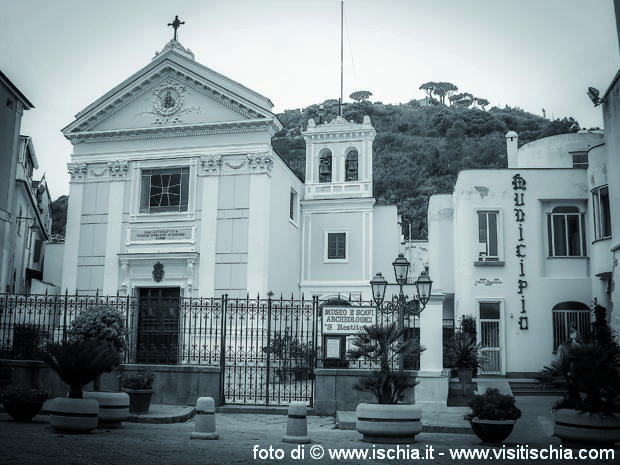Restituta or of the five churches

The story of Restituta from Africa, the Christian martyr of the third century AD who is the Patron Saint of the island of Ischia from time immemorial, is shrouded in legend or in the miracle of Fait.
Restituta was a girl of Bizerte, a city in the today’s Tunisia and converted to Catholicism suffering the persecution of Emperor Diocletian till martyrdom.
She was placed in a boat “load of tow steeped in resin and pitch and burned,” but the boat did not burn and an angel took her soul in heaven and her mortal remains far, far away from the African coast up to a land in the bay of San Montano in today’s Lacco Ameno on the island of Ischia then called Aenaria. A long journey in the middle of May, favored by the sirocco wind.
“A pious woman named Lucina lived in that place, and appeared out of the blue a vision of the Angel of the Lord and told her the story of the martyrdom of Restituta giving also the mandate to go to S. Montano, to collect the body of the martyr and to bury it with great reverence”, Don Pasquale Polito writes in his book “Lacco Ameno: il paese, la protettrice, il folclore” of 1963.
Lucina did exactly what Angel had told her. She buried Restituta in the place where the Christians gathered and began to worship and spread the cult.
This story has been passed down from generation to generation for centuries. How much of historical truth and how much of a legend is there?
Don Pietro Monti was 35 years old in 1950 and was for some years the Rector of the Sanctuary of Santa Restituta, the most important Christian sanctum of Lacco Ameno of the seventeenth century and the nineteenth century with the beautiful neoclassical facade on the square. It consists of two buildings: the “big church” rebuilt after the earthquake of 1883 through the intervention of Cardinal Guglielmo Sanfelice, archbishop of Naples and Msgr. Gennaro Portanova, bishop of Ischia and opened with “big party” in 1886 and the “little church”, the oldest one, whose original structure was built in the ninth century. C.
It was the morning of April 12, 1950 and started the restoration of the “little church”. The intent of Don Pietro Monti was not an archaeological exploration since then the hypothesis of early Christian finds was not taken into account.
The Rector of the Sanctuary indented to change the floor of the church and to make some changes and some restoration to the altar. The discovery was the under the floor there was another church or maybe more than one, real a spontaneous and unexpected surprise.
Years later Don Pietro tells that “when under the blows of the pick and the cut of the material began to surface a second, a third and a fourth floor, I found myself in front of a Roman clay floor and kept close to plates of a Christian grave, I was obliged to go the whole hog to see in the bowels of that ‘virgin’ land what there was that could interest the history and the archeology”. Excavations were started and lasted twenty-five years thanks to the passion of the priest-archaeologist who began to set up a museum widening the search to all other archaeological sites of the island of Ischia. Don Pietro brings to light two civilizations: the Roman and Christian one.
The floor of the “little church” concealed four churches: the first one of the third century AD which was the center of Christianity of the whole island of Ischia, where the mortal remains of Santa Restituta were kept, the second one of the ninth century BC was rebuilt by Count Marino on the ruins of the first basilica, during this period the mortal remains of Santa Restituta were transferred to the Duomo of Naples for fear of looting by the Maori invasions; the third church of the fourteenth century when in 1374 Mons. Bartolomeo Bussolaro, Bishop of Ischia provided for the construction of a defensive wall inside the church, which became a place of pilgrimage from all the villages on the island, the fourth largest church of the seventeenth century with a dedication to S. Maria del Carmine, whose image is venerated today, work by Decio Tramontano (1560), and finally the fifth church that is what we see today, consists of the “great” and that “tiny” church.
From that day of April in1950 Don Pietro Monti, a friend of the priest-archaeologist Amedeo Maiuri, the eminent archaeologist who Don Pietro considered his Master, for fifty-five years until his death in 2005 at age 93, dedicated his life to the extension of the Museo di Santa Restituta and to write preserving the memory of the discoveries giving the media two important volumes: “Ischia, archeologia e storia” a volume of 830 pages and “Ischia, Altomediovale”, a volume of 335 pages in addition to spreading the cult of Restituta with small informative volumes.
The Museo di Santa Restituta with the Sanctuary and the excavations are now an inseparable part of the Diocesan Museum and are managed by the Diocesan administration but are carried out between three volunteers: Mr. Filippo De Siano, Don Pietro’s grandson, his wife Caterina Iacono and Mr. Lucio Patalano who take care the ticket office and the visit helped –
the reporter Ms. Caterina explains - by “two grandmothers, Immacolata Patalano and Maria Cacciutto.
“Ours is a voluntary commitment to carry forward the work of Don Pietro, who many years ago with a group of young people taught us to love our roots”, Ms. Caterina says while a group of young German students of the town of Kircheim, whose Scholastic Institute is affiliated with our Technical Institute Mattei of Casamicciola led by Professor Olimpia De Angelis, visit the Museum.
May is the month of Santa Restituta. The festivities start on May 16th and lasted until May 18th.Don Pietro also wanted to renew the arrival of the Saint in the bay of San Montano with a performance almost to make History the Legend in the strength of the Faith.
May is the month of the sirocco wind. In those three days, the island of Ischia was beaten by this warm wind that comes from Africa. All the islanders from time immemorial say it is “the sirocco of Santa Restituta”.


































